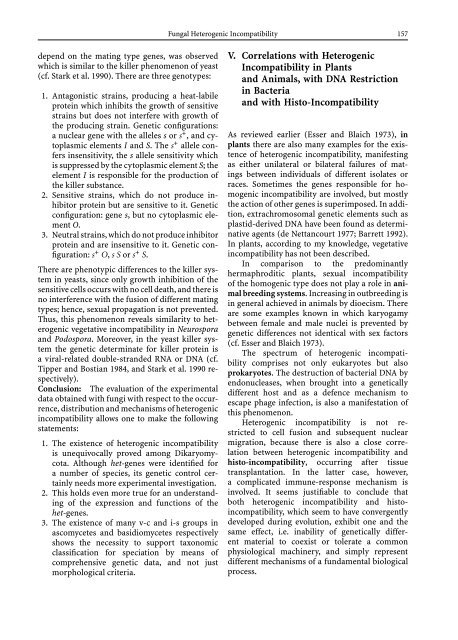Growth, Differentiation and Sexuality
Growth, Differentiation and Sexuality
Growth, Differentiation and Sexuality
Create successful ePaper yourself
Turn your PDF publications into a flip-book with our unique Google optimized e-Paper software.
dependonthematingtypegenes,wasobserved<br />
which is similar to the killer phenomenon of yeast<br />
(cf. Stark et al. 1990). There are three genotypes:<br />
1. Antagonistic strains, producing a heat-labile<br />
protein which inhibits the growth of sensitive<br />
strains but does not interfere with growth of<br />
the producing strain. Genetic configurations:<br />
a nuclear gene with the alleles s or s + , <strong>and</strong> cytoplasmic<br />
elements I <strong>and</strong> S. Thes + allele confers<br />
insensitivity, the s allele sensitivity which<br />
is suppressed by the cytoplasmic element S;the<br />
element I is responsible for the production of<br />
the killer substance.<br />
2. Sensitive strains, which do not produce inhibitor<br />
protein but are sensitive to it. Genetic<br />
configuration: gene s, but no cytoplasmic element<br />
O.<br />
3. Neutral strains, which do not produce inhibitor<br />
protein <strong>and</strong> are insensitive to it. Genetic configuration:<br />
s + O, sSor s + S.<br />
There are phenotypic differences to the killer system<br />
in yeasts, since only growth inhibition of the<br />
sensitive cells occurs with no cell death, <strong>and</strong> there is<br />
no interference with the fusion of different mating<br />
types; hence, sexual propagation is not prevented.<br />
Thus, this phenomenon reveals similarity to heterogenic<br />
vegetative incompatibility in Neurospora<br />
<strong>and</strong> Podospora. Moreover, in the yeast killer system<br />
the genetic determinate for killer protein is<br />
a viral-related double-str<strong>and</strong>ed RNA or DNA (cf.<br />
Tipper <strong>and</strong> Bostian 1984, <strong>and</strong> Stark et al. 1990 respectively).<br />
Conclusion: The evaluation of the experimental<br />
data obtained with fungi with respect to the occurrence,<br />
distribution <strong>and</strong> mechanisms of heterogenic<br />
incompatibility allows one to make the following<br />
statements:<br />
1. The existence of heterogenic incompatibility<br />
is unequivocally proved among Dikaryomycota.<br />
Although het-genes were identified for<br />
a number of species, its genetic control certainly<br />
needs more experimental investigation.<br />
2. This holds even more true for an underst<strong>and</strong>ing<br />
of the expression <strong>and</strong> functions of the<br />
het-genes.<br />
3. The existence of many v-c <strong>and</strong> i-s groups in<br />
ascomycetes <strong>and</strong> basidiomycetes respectively<br />
shows the necessity to support taxonomic<br />
classification for speciation by means of<br />
comprehensive genetic data, <strong>and</strong> not just<br />
morphological criteria.<br />
Fungal Heterogenic Incompatibility 157<br />
V. Correlations with Heterogenic<br />
Incompatibility in Plants<br />
<strong>and</strong> Animals, with DNA Restriction<br />
in Bacteria<br />
<strong>and</strong> with Histo-Incompatibility<br />
As reviewed earlier (Esser <strong>and</strong> Blaich 1973), in<br />
plants there are also many examples for the existence<br />
of heterogenic incompatibility, manifesting<br />
as either unilateral or bilateral failures of matings<br />
between individuals of different isolates or<br />
races. Sometimes the genes responsible for homogenic<br />
incompatibility are involved, but mostly<br />
the action of other genes is superimposed. In addition,<br />
extrachromosomal genetic elements such as<br />
plastid-derived DNA have been found as determinative<br />
agents (de Nettancourt 1977; Barrett 1992).<br />
In plants, according to my knowledge, vegetative<br />
incompatibility has not been described.<br />
In comparison to the predominantly<br />
hermaphroditic plants, sexual incompatibility<br />
of the homogenic type does not play a role in animal<br />
breeding systems. Increasing in outbreeding is<br />
in general achieved in animals by dioecism. There<br />
are some examples known in which karyogamy<br />
between female <strong>and</strong> male nuclei is prevented by<br />
genetic differences not identical with sex factors<br />
(cf. Esser <strong>and</strong> Blaich 1973).<br />
The spectrum of heterogenic incompatibility<br />
comprises not only eukaryotes but also<br />
prokaryotes. The destruction of bacterial DNA by<br />
endonucleases, when brought into a genetically<br />
different host <strong>and</strong> as a defence mechanism to<br />
escape phage infection, is also a manifestation of<br />
this phenomenon.<br />
Heterogenic incompatibility is not restricted<br />
to cell fusion <strong>and</strong> subsequent nuclear<br />
migration, because there is also a close correlation<br />
between heterogenic incompatibility <strong>and</strong><br />
histo-incompatibility, occurring after tissue<br />
transplantation. In the latter case, however,<br />
a complicated immune-response mechanism is<br />
involved. It seems justifiable to conclude that<br />
both heterogenic incompatibility <strong>and</strong> histoincompatibility,<br />
which seem to have convergently<br />
developed during evolution, exhibit one <strong>and</strong> the<br />
same effect, i.e. inability of genetically different<br />
material to coexist or tolerate a common<br />
physiological machinery, <strong>and</strong> simply represent<br />
different mechanisms of a fundamental biological<br />
process.

















